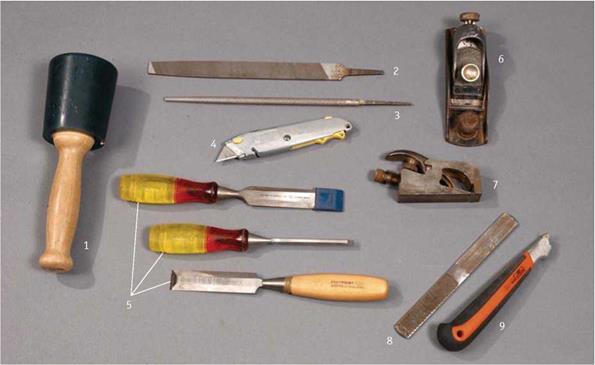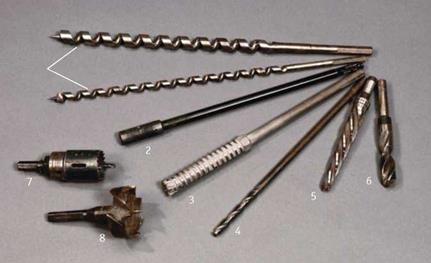HAND CUTTING AND SHAPING TOOLS
Power tools can do a lot, but you often need a hand tool to finish the job.
Chisels clean up the corners of a hinge mortise that a router can’t reach and quickly notch plates so washers sit flush. Be sure to sheathe cutting edges so they stay sharp and don’t cut you when you reach for them.
Mallets can strike chisels without damaging their handles.
Utility knives are indispensable. Quick-blade- change knives dispense fresh blades so you don’t need to unscrew the knife’s body. Don’t use knives with cheap, snap-off blades (often sold at stationery or office-supply stores) to cut construction materials; such blades can break unexpectedly and injure you.
Rat-tail files smooth and enlarge holes and create an oval slot after two holes are drilled close to each other.
Flat files take burrs off newly cut bolts and the like, so you can start a washer.
Four-in-one rasps contain two flat and two curved rasps in one wood-shaping tool.
 Block planes shave off tiny amounts of wood from door edges, casings, and other thin stock, allowing tight, final fits of materials.
Block planes shave off tiny amounts of wood from door edges, casings, and other thin stock, allowing tight, final fits of materials.


 Bullnose planes can fine-shave wood edges in tight places. Bullnose blades are the same width as plane shoes. You can remove the bullnose front piece, allowing you to plane right up to the juncture of an adjoining piece.
Bullnose planes can fine-shave wood edges in tight places. Bullnose blades are the same width as plane shoes. You can remove the bullnose front piece, allowing you to plane right up to the juncture of an adjoining piece.
Bahco® by Snap-On®, carbide scrapers are
not intended to shape wood, but their blades are so sharp that you can. Instead use them to remove dried putty or excess Bondo™ or to clean up the spurs of medium-density fiberboard (MDF) that screws sometimes kick up.
A %-in. cordless drill is a must. These days, builders use screws to install almost everything from exterior trim to decks and drywall. You can get more voltage and bigger chucks, but this size has a good weight to power ratio. Get a reversible, variable-speed model with a keyless chuck, adjustable clutch, and an extra battery.
A WELL-KEPT
Though little known, cordless impact drivers do almost everything a cordless drill or driver does —and better. Unlike drills, impact drivers have collets that receive only hex-drive bits, sockets, and the like. But that’s an advantage: Hex-head screw bits won’t slip out of screws and crash into finish surfaces. And impact drivers have twice as much power as drill/drivers of the same size because the tool delivers its torque in intermittent pulses. Thus you can drive 4-in. wood screws or ^-in. lag bolts without needing to lean into the tool, as you must with most drills. This is a real plus for anyone prone to wrist strain. Impact drivers are a bit slower and noisier than drills, but that’s a small price to pay.
|
Cordless drills and drivers. From left: Impact driver, close-quarters right-angle drill, standard drill. |
1
A %-in., corded, pistol-grip drill has the sustained run-time that cordless drills lack, more power, and a side handle to help you control its torque. It drills 1-in. or l^-in. holes easily, but use a /2-in. right-angle drill if you’re roughing in plumbing systems.
A %-in. close-quarter cordless drill is best for tight spaces like cabinet interiors. Its right-angle configuration extends your reach when you are hanging upper cabinets.
A standard drill nest contains Иб-in. to J4-in. twist drill bits. From there, you’re on your own. The following specialized bits are quite useful.
Vix® bits have spring-loaded drives that accurately center holes predrilled for hinges, striker plates, window pulls, etc.
Self-feeding auger bits drill through posts for bolts and through wall plates for hold-downs. A 12-in. by!4-in. auger doubles as an exploratory bit.
Hole saws drill large-diameter holes in finish materials such as doors and countertops. The pilot bit in the middle emerges on the backside first, so you can retract the bit and center it to finish drilling from the other side. This lets you avoid wood “bust-through,” splintering backsides.
A plumber’s bit is a wide, self-feeding auger bit good for rough-in framing work.
Reamers are tapered bits that enlarge an existing hole in metal or wood.
Large twist drill bits, also called aircraft bits, are best suited for drilling metal.







Leave a reply